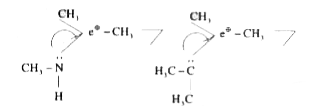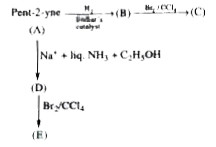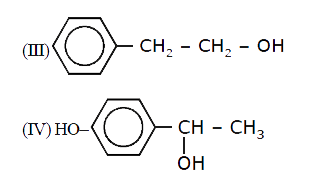Addition of HX on alkene proceed through formation of carbocation . This reaction is follows Markovnikov's rule. According to markovnikov's rule addition of electrophile occurs on that carbon of alkene which have more number of -H atom
Ph−CH=CH2−−→HXPh−x∣CH−CH3(major)+Ph−CH2−CH2−X(minor)
Which of the following alkenes will give markovnikov's reaction ?Solution in Telugu
P>Q>R>S
R>Q>P>S
S>R>Q>P
Q>R>P>S
The correct Answer is:B
Stability of intermediate carbocation given in the following


N.atom is less electro negative. So loan pair of nitrogen atom participating in resonance then oxygen atoms so 1 is more stable than 2, 4 is less table because of -I effect of −OCH3
Topper's Solved these Questions
- BOOK - AAKASH SERIESCHAPTER - HYDROCARBONSEXERCISE - ADDITIONAL PRACTICE SHEET ( LEVEL-II (LECTURE SHEET (ADVANCED) (LINKED COMPREHENSION TYPE QUESTIONS(PASSAGE-II))))2videos
HYDROCARBONS
- BOOK - AAKASH SERIESCHAPTER - HYDROCARBONSEXERCISE - ADDITIONAL PRACTICE SHEET ( LEVEL-II (LECTURE SHEET (ADVANCED) (LINKED COMPREHENSION TYPE QUESTIONS(PASSAGE-III))))3videos
HYDROCARBONS
- BOOK - AAKASH SERIESCHAPTER - HYDROCARBONSEXERCISE - ADDITIONAL PRACTICE SHEET ( LEVEL-II (LECTURE SHEET (ADVANCED) (MORE THAN ONE CORRECT ANSWER TYPE QUESTIONS)))20videos
HYDROCARBONS
- BOOK - AAKASH SERIESCHAPTER - GENERAL ORGANIC CHEMISTRYEXERCISE - QUESTIONS FOR DESCRIPTIVE ANSWERS35videos
GENERAL ORGANIC CHEMISTRY
- BOOK - AAKASH SERIESCHAPTER - HYDROGEN AND ITS COMPOUNDSEXERCISE - QUESTIONS FOR DESCRIPTIVE ANSWERS20videos
HYDROGEN AND ITS COMPOUNDS
Similar Questions
Hydroboration is a reaction in which the boron hydride acts as an electrophile, R2BH adds to a carbon - carbon double which acts as a nucleophile

Organoborane compound The organoborane compound then is oxidised by treatment with hydrogen peroxide in aqueous sodium hydroxide to from alcohol. The OH group enters the carbon atom from the same side where the boron atom was present. Hence this reaction is highly regioselective and the boron atom attacheto that carbon atom which is less sterically hindred.
 04:00View Solution
04:00View Solution
Compounds (B) and (D) are, respectively05:42View SolutionWhich would give isobutane on decarboxylation ?
03:55View SolutionMention the hybridisation stste of each carbon in the following compounds.
CH3−CH=C=O,CH3−C≡C−CH3,CH3COCH3andCH2=CHCN03:28View SolutionWhy the use of hard water is disadvantages?
03:59View SolutionIn the reaction with HCl, an alkene reacts in accordance with the Markovnikov's rule. The possible alkene is
05:41View SolutionAddition of HX on alkene proceed through the formation of carbocation .This reaction is also kjnown as Markownikoff reaction.Accroding to Markownikoff's rule addition of electrophile occurs on theat crbon of alkene which have mor number of 'H' atom. Which of the Following alkenes will give Markownikoff reaction?
02:33View SolutionWhich of the following reactions will give the major and minor products? CH_3-CH_2underset(Br)underset(|)(CH)-CH_3underset("heat")overset(alc. KOH)toCH_3-underset((A))(CH=CH)+underset((B))(CH_3-CH_2-CH=CH_2)
02:04View SolutionCompare the rate of dehydration of the following alcohols (I)Ph−C∣Ph−CH2−OH
(II)Ph−OH∣CH−CH3
 02:15View Solution
02:15View SolutionThe alkenes have π-bonds which make them highly reactive. These undergo electrophilic addition reactions, Addition of HX to unsymmetrical alkenes gives two products and follow Markovnikov rule and anti- Markovnikov rule. The addition occure through the formation of carbocation in Markovnikov rule and free radicals in anti-Markovnikov zule. The ozonolysis reaction of alkenes helps to locate the position of double bond.
Predict the major product in the following reaction:
CH3−CH=CH2HBr−−−−−−→(PhCOO)203:56View SolutionThe alkenes have pi -bonds which make them highly reactive. These undergo electrophilic addition reactions, Addition of HX to unsymmetrical alkenes gives two products and follow Markovnikov rule and anti- Markovnikov rule. The addition occure through the formation of carbocation in Markovnikov rule and free radicals in anti-Markovnikov zule. The ozonolysis reaction of alkenes helps to locate the position of double bond. Write the major product in the following reaction: CH_(3)- overset(CH_(3))overset(|)CH-CH=CH_(2) overset(HBr)to
03:51View SolutionWhich of the following reactions will give the major and minor products?
CH3−CH2CH∣Br−CH3alc.KOH−−−−−→heatCH3−CH=CH(A)+CH3−CH2−CH=CH2(B)02:02View SolutionPh−CH2−C∣DH−CH3Br2/hv−−−−→ Product of the above reaction will be :
View SolutionAddition of HX on alkene proceed through formation of carbocation . This reaction is follows Markovnikov's rule. According to markovnikov's rule addition of electrophile occurs on that carbon of alkene which have more number of -H atom
Ph−CH=CH2−−→HXPh−x∣CH−CH3(major)+Ph−CH2−CH2−X(minor)
Which of the following alkenes can produce diastereomersView SolutionAddition of HX on alkene proceed through formation of carbocation . This reaction is follows Markovnikov's rule. According to markovnikov's rule addition of electrophile occurs on that carbon of alkene which have more number of -H atom
Ph−CH=CH2−−→HXPh−x∣CH−CH3(major)+Ph−CH2−CH2−X(minor)
Which of the following alkenes will give markovnikov's reaction ?View SolutionAddition of HX on alkene proceed through formation of carbocation . This reaction is follows Markovnikov's rule. According to markovnikov's rule addition of electrophile occurs on that carbon of alkene which have more number of -H atom Ph-CH = CH_2 underset(HX)to underset("(major)")(Ph-overset(x)overset(|)CH-CH_3) + underset("(minor)")(Ph-CH_2-CH_2-X) Arrange the following alkenes in decreasing order of reaction with HBr.
03:48View Solution
